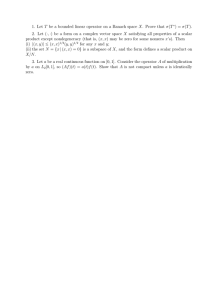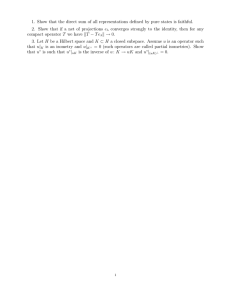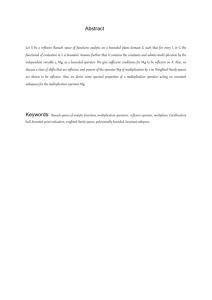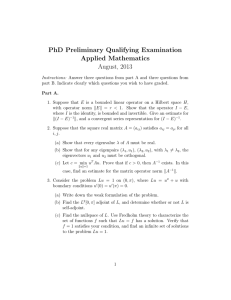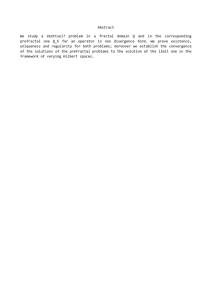the berezin symbol and multipliers of functional hilbert spaces
advertisement
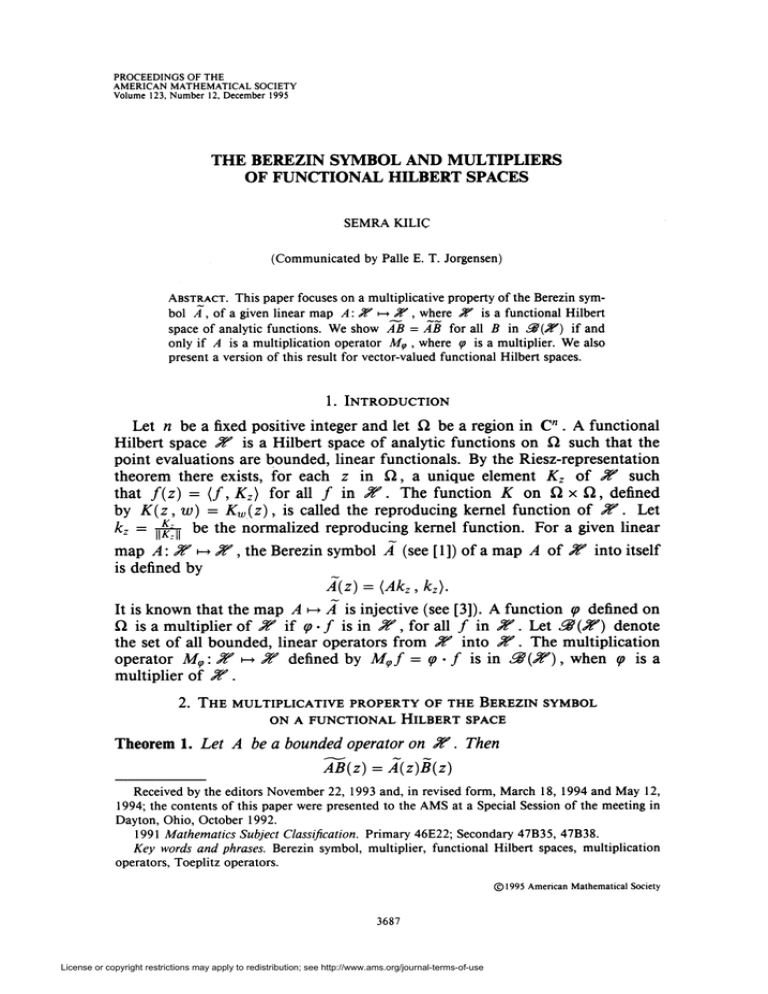
proceedings of the
american mathematical society
Volume 123, Number 12, December 1995
THE BEREZIN SYMBOLAND MULTIPLIERS
OF FUNCTIONALHILBERT SPACES
SEMRAKILIÇ
(Communicated by Palle E. T. Jorgensen)
Abstract. This paper focuses on a multiplicative property of the Berezin symbol A , of a given linear map A : %? t-> %?, where %? is a functional Hubert
space of analytic functions. We show AB = AB for all B in 3S{Sf) if and
only if A is a multiplication operator Mv , where <p is a multiplier. We also
present a version of this result for vector-valued functional Hubert spaces.
1. Introduction
Let « be a fixed positive integer and let Q be a region in C" . A functional
Hubert space ^ is a Hubert space of analytic functions on Q such that the
point evaluations are bounded, linear functionals. By the Riesz-representation
theorem there exists, for each z in Q, a unique element Kz of ßf such
that f(z) = (f,Kz)
for all / in MT. The function K on Q x Q, defined
by K(z, w) = Kw(z), is called the reproducing kernel function of 2?. Let
kz — pSr be the normalized reproducing kernel function. For a given linear
map A: £? h->%?, the Berezin symbol A (see [1]) of a map A of %? into itself
is defined by
A(z) = (Akz,kz).
It is known that the map A >->A is injective (see [3]). A function g>defined on
Q is a multiplier of %? if q>• f is in %?, for all / in %?. Let 38(%e) denote
the set of all bounded, linear operators from %? into %?. The multiplication
operator M9 : %? >->%? defined by M9f = q>• f is in 38(%?), when tp is a
multiplier of X.
2. The multiplicative
property
ON A functional
of the Berezin symbol
Hilbert
space
Theorem 1. Let A be a bounded operator on £?. Then
AB(z) = Ä(z)B(z)
Received by the editors November 22, 1993 and, in revised form, March 18, 1994 and May 12,
1994; the contents of this paper were presented to the AMS at a Special Session of the meeting in
Dayton, Ohio, October 1992.
1991 Mathematics Subject Classification. Primary 46E22; Secondary 47B35, 47B38.
Key words and phrases. Berezin symbol, multiplier, functional Hilbert spaces, multiplication
operators, Toeplitz operators.
©1995 American Mathematical Society
3687
License or copyright restrictions may apply to redistribution; see http://www.ams.org/journal-terms-of-use
3688
SEMRAKJLIÇ
for all B in 38'(ß?) if and only if A is a multiplication operator, My, where
(p is a multiplier. Moreover, <p= A.
Before proceeding with the proof, we need the following:
Lemma 1. When <pis a multiplier ofßff', Mf(z) —<p(z).
Proof. M^z) = (Mvkz, kz) = (q>kz,kz) = <p(z).
Lemma 2. The Berezin symbol of f ® g, for f, g in ß?, is
llAz||
Proof. For / and * in ß? and z in Q,
{f ®g){z)= {{f ®g)
K7
K7
11**11
11**11
l—(Kz,g)(f,Kz)
ll*z
By the reproducing property of the kernel function, we have
(f®g)(z) = ^¡-2f(z),
f,qeßf.
Proof of Theorem 1. Suppose AB(z) = Ä(z)B(z) for all B in &(ß?).
B = f ® g for / and * in ß?. Then, by Lemma 2,
Let
Jiz)
AB(z) = (Af®g)(z) = J±±L(Af)(z).
II*
By the hypothesis, we have
Z)Mf)(z) = -^r%Ä(z)f(z),
\\KZ\\2K
J,K
'
\\KZ\\2'
which reduces to
(Af)(z)=Ä(z)f(z)
for all /J in ß?. Hence A = M~.
A
Conversely, if A is a multiplication operator, M<¡,, where <pis a multiplier,
M^B = (M,Bkz, kz) = <p(z){B.^){*]
for all B in &(ße).
By Lemma 1, we have
M^B(z) = Mv(z)B(z)
for all B in &(ß?).
Corollary 1. Let B be in &(ß?). Then
AB(z) = Ä(z)B(z)
for all A in 38 (ß?) if and only if B = M*, where y/ is a multiplier.
Proof. The assertion follows from Theorem 1 and the fact that T*(z) = T(z),
for all T in
License or copyright restrictions may apply to redistribution; see http://www.ams.org/journal-terms-of-use
THE BEREZINSYMBOLAND FUNCTIONALHILBERTSPACES
3689
The Hardy space H2 consists of the complex-valued analytic functions on the
unit disk D such that the Taylor coefficients are square summable. A calculation
shows that Kz = -^=-- has the reproducing property (see [4]). Let P denote the
orthogonal projection of L2(f9D) onto H2, and let tp be a bounded measurable
function. Then the Toeplitz operator, Tv , induced by g>is defined by T^f -
P(<pf), for all /in//2.
Corollary 2. Let A be a bounded operator on H2. Then
AB(z) = A(z)B(z)
for all B in 38(H2) if and only if A isa Toeplitzoperator, Tç, induced by q>
in H°° . Moreover tp —A.
Proof. The multiplication operators on H2 are the analytic Toeplitz operators.
We should mention that Corollary 2 is also true if one replaces H2 by the
Bergman space or any of the weighted Bergman spaces. (For analytic Toeplitz
operators on weighted Bergman spaces see [6].)
3. The multiplicative property of the Berezin symbol
on the analytic reproducing kernel space, ß? = ß?Q® ^
Let Jo be a functional Hilbert space of (scalar-valued) analytic functions
on fí with the reproducing kernel function Kz, for each fixed z in A. Let
^ be a separable Hilbert space, and let ße be the functional Hilbert space of
fé'-valued functions, ßf = ß^®^.
The reproducing kernel function of ße,
3z:W^ße,is
defined by 3z(u) = Kz®u, where u is in ^.
The evaluation functional Ez : ß? »-►
^, defined by Ezf = f(z), for z in
Q, is bounded (see [2], Lemma 3.2). For f eßf, u in W, we have
(f,E*zu)jr = (f(z),u)v.
We also have the reproducing property of the kernel function, that is
(f,3z(u))jr
= (f(z),u)w.
Therefore, E*u- 3z(u), for all u in &. By the reproducing property of the
kernel function, we have ||3z(w)||2 = Ä^z(z)||w||2, where u is in W, and hence
P2\\ = y/K&) =\\EZ\\.
Let Xz — pSr be the normalized reproducing kernel function, and let A be
a bounded linear operator on ße. Then the Berezin symbol A of A is defined
by
Ä(z) = 3?z*AXZ.
Lemma 3. An operator A is a multiplication operator if and only if, for each
fixed z in Q, A*E* =£*0(z)* for some operator <P(z) in 38&). Moreover,
in this case, A is the operator of multiplication by the function z \->Q>(z).
Proof. Let z be fixed in fí. Suppose A is a multiplication operator, M<¡,,
induced by <t>:Q -> ^(g7). We observe that
EzM*f = Af*/(z) = ®(z)f(z) = <î>(z)Ezf for all / in ßf.
Then we have EZM^ = Q>(z)Ez, for some operator O(z) in 38&).
License or copyright restrictions may apply to redistribution; see http://www.ams.org/journal-terms-of-use
3690
SEMRAKILIÇ
Conversely, let A be a bounded operator on ße such that A*E* = E*<b(z)*
for some operator O(z) in 38 &). For u in ^, we have
</, ¿P^u)^
. (Af, E*zu)jr= ((Af)(z), u)v for all / in 3T.
On the other hand, for u in W, we have (/, £*<P(z)*w)= (0(z)/(z),
w), for
all / in ße. Then ((Af)(z), u) = (0(z)/(z), u), for all / in JT and « in
W. Therefore, (Af)(z) = <D(z)/(z), for all / in X.
Theorem 2. Let A be a bounded operator on ße. Then
AB(z) = A(z)B(z)
for all B in 3B{MT)if and only ifA = M*, where <D:Q •->.#(«').
Proof. We observe that EzM^f = *(z)/(z), for all / in ßf. Then EZM®E*
= 0(z)£z.E; and EzMqBE¡ = <b(z)EzBE*, for all B in ^(¿T).
Since
EZE* = Kz(z)fy , we have A/* = <P(z) and
_.
F r/t*
M*B(z) = O(z) 2
_
_
/ = M«,(z)£(z)
IP*II
for all 5 in ^(¿F).
^ Conversely, suppose that /I is a bounded operator such that AB(z) —
A(z)B(z) for all B in 38(ße). Then from the definitions, we get
EZABE* = ^r-^EzAE*zEzBE*z for all fi in 38(ße).
Il-^zll
For « and v in ^, we have
IF AF*
(EzABE*zu, v) = (-I—LEzBE*u,
\
~
v\ = (A(z)EzBE*u,
v).
Then we have
(BE*zu, A*E*zv)= (BE*u, E*zA(z)*v).
For each fixed nonzero u, BE* u runs through all vectors in ße as B runs
through all elements of 38(ß?). Thus we see that A*E* = E*Ä(z)*, for all z
in Q. Therefore A is a multiplication operator, M~, by Lemma 3.
Let us note that if we take ^ to be C and define 3?z = kz <g>
1, the sufficiency
proof of Theorem 2 will also work for Theorem 1, the scalar-valued case.
Let N = {0, 1,2,...}
denote the set of nonnegative integers. The set N"
is partially ordered by setting I = (ix, i2, ... , in) > (jx, j2,... , j„) = J if
and only if ik > jk for k = 1, 2, ... , n. If z = (zx, z2,... , z„) is in
Q, then we set zl = z\ • z'22.zlnn.
We denote by H2(n) ® W, where
H2(n) - H2 ® H2 ® • • • ® H2 (n copies), the set of all vector-valued analytic
functions /: D" ►-►
^ with power series expansion f(z) = S/eN" z'vi > w^m
v¡ in & and z in D", such that ¿3/eN"llalli < °° •
The space H2(n)®W is a Hilbert space with the reproducing kernel function,
3Z: W h->H2(n) <8>
fê, for z in D" , defined by 3z(u) = Kz®u, where u is
in ^ and Kz(w) = 2w6N" ^'w1 is the reproducing kernel function for H2(n)
(see [5]). Let H°°(n)(3?(&)) denote the Banach space of all bounded analytic
functions <D:D" .-> 38(%) with the norm ||0||oo = sup{||<P(z)||, for z e D"} .
License or copyright restrictions may apply to redistribution; see http://www.ams.org/journal-terms-of-use
THE BEREZIN SYMBOLAND FUNCTIONAL HILBERT SPACES
3691
For every O in H°°(n)(38i^)), we can define the analytic Toeplitz operator
T<5>
in 38(H2(n)®^) as follows:
(7W)(z) - <t>(z)f(z),
z in D", / in H2(n) ® «?.
For the boundedness of the map T® see [2].
Corollary 3. Let A be a bounded operator on H2(n) ® fë. Then
AB(z) = Ä(z)B(z)
for all B in 38(E2(n)®^) if and only if A^T^, where <D¿sin H°°(n)(^(W)).
Acknowledgment
I thank my thesis advisor, Eric Nordgren, for his encouragement and support
throughout my work. Also, I thank the referee for several helpful suggestions.
References
1. F. A. Berezin, Covariant and contravariant symbols for operators, Math. USSR-Izv. 6 ( 1972),
1117-1151.
2. R. E. Curto and N. Salinas, Generalized Bergman kernels and the Cowen-Douglas theory,
Amer. J. Math. 106 (1984), 447-488.
3. V. Guillemin, Toeplitz operators in n-dimensions, Integral Equations Operator Theory 7
(1984), 145-204.
4. P. R. Halmos, A Hilbert space problem book, Van Nostrand, Princeton, NJ, 1967.
5. G. T. Adams, J. Froelich, and V. I. Paulsen, Analytic reproducing kernels and factorization,
Indiana Univ. Math. J. 43 (1994), 839-856.
6. K. Zhu, Operator theory in function spaces, Marcel Dekker, New York, 1990.
Department
of Mathematics,
University
of New Hampshire, Durham, New Hampshire
03824
Current address : Simon's Rock College of Bard, 84 Alford Rd., Great Barrington, Massachusetts
01230-9702
License or copyright restrictions may apply to redistribution; see http://www.ams.org/journal-terms-of-use
